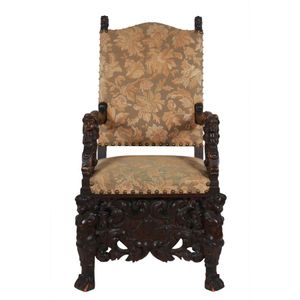Jacobean Oak Armchairs with Upholstery
You must be a subscriber, and be logged in to view price and dealer details.
Subscribe Now to view actual auction price for this item
When you subscribe, you have the option of setting the currency in which to display prices to $Au, $US, $NZ or Stg.
- Jacobean - Jacobean is the name applied to the style of furniture and decorative arts in vogue from about 1600 to 1630 which includes the reign of James I (1603-1625). The most common timber used is oak, and it is ornamented with turning and elaborate carving. Characteristic of decoration of furniture in this style are bun feet, mortice and tenon joints (replacing dowell joints) and 'X' frame chairs.
The style was revived in the 19th furniture (Jacobean Revival or "Jacobean style") as represented by most of the furniture coming onto the market in Australia, that is described as "Jacobean". - Oak - Native to Europe and England, oak has been used for joinery, furniture and building since the beginning of the medieval civilisation. It is a pale yellow in colour when freshly cut and darkens with age to a mid brown colour.
Oak as a furniture timber was superceded by walnut in the 17th century, and in the 18th century by mahogany,
Semi-fossilised bog oak is black in colour, and is found in peat bogs where the trees have fallen and been preserved from decay by the bog. It is used for jewellery and small carved trinkets.
Pollard oak is taken from an oak that has been regularly pollarded, that is the upper branches have been removed at the top of the trunk, result that new branches would appear, and over time the top would become ball-like. . When harvested and sawn, the timber displays a continuous surface of knotty circles. The timber was scarce and expensive and was used in more expensive pieces of furniture in the Regency and Victorian periods.
This item has been included into following indexes:
-
chairs, singles / pairs / threes, style or period
- armchairs 1,732
- Jacobean style 22
- chairs, singles / pairs / threes, timber - oak 488
Visually similar items

A tapestry top turned walnut stool, English, late 19th century, 37 cm high, 52 cm wide, 40 cm deep


Renaissance revival throne chair English oak, with carved griffin, cherub, & coat of arms on rear, embroidered upholstery

Miner's jarrah and pine settee, c. 1870, with scalloped back and open side arms a loose cushion covered with banksia printed fabric by Bruce Goold, height 102 cm width 200 cm depth 71 cm. Provenance: The Estate of Ray Hughes
